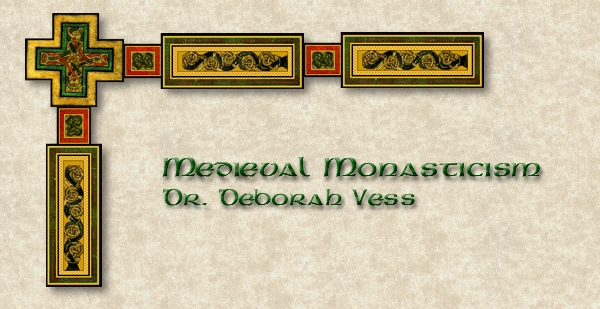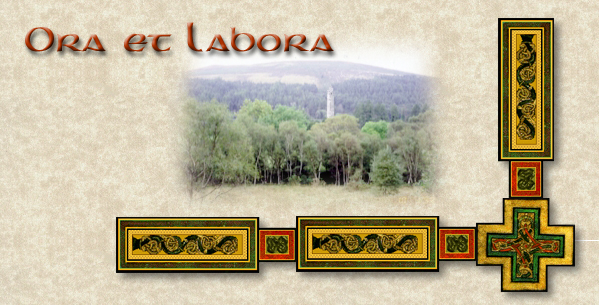
The Cistercians and Trappists
Brief Introduction to the Cistercians
by Dr. Vess
The motivations behind Robert's exodus from Molesme are one of the perplexing issues surrounding the origin of Cīteaux. Corruption was seeping into the Church during the tenth and eleventh centuries. Even Cluny, which had originated in the desire to free the Church from worldly influences, had itself become wealthy and its monks had departed from strict observance of the Benedictine Rule. Cluniac monks spent most of their time reciting the Divine Office, which resulted in the almost total neglect of manual labor. The pious reputation of Robert and his followers soon began to attract benefactors. Laymen believed in the efficacy of the prayers of Molesme, and they donated lands, churches, and villages to the new community. These donations inevitably drew Molesme into feudal society. Although Robert had aspired to lead a life apart from worldly influences, Molesme's success inevitably began to corrupt that ideal. By all accounts, however, Molesme was a model black monk monastery. Although many black monk institutions of the time were corrupt, such as the monastery of Farfa in Italy, the monks of Molesme were known for their pious lives and for their observance of the Benedictine Rule.
- It is likely that corruption was not the real issue which led to Robert's exodus from Molesme. Early in his life, Robert had been a monk at the monastery of Saint Ayoul. In 1074 he left this monastery to lead a group of hermits in the forest at Collan. Robert began to attract followers, and soon he was forced to find a more suitable place. The Maligny family donated Molesme to him, which was located in a particularly savage and untamed region. During the first few years at Molesme, the monks endured great hardships, and they were often without food and clothing. This was the sort of life that most appealed to Robert; it was his misfortune that all the places to which he went eventually lapsed from such practices. Sometime during 1090-1093 he left Molesme to live with a group of hermits at Aux, but the brothers appealed to the hierarchy and he was ordered to return. These events suggest that it was Robert's predilection for a life of solitude, rather than actual defects of the practices at Molesme, which accounts for his departure from Molesme. In 1098 he left Molesme and founded Cīteaux in what has been described as "a wasteland of howling desert," once again seeking to practice a severe form of austerity and desert discipline. Within a few months of his departure, the monks of Molesme appealed to the pope, who ordered Robert to return.
As with his previous foundations, however, Robert's "novum monasterium" soon achieved the very success which had driven him from Molesme. Robert never lived to see this transformation, which began with the arrival in 1113 of the young Burgundian noble Bernard and his thirty-three companions. Bernard soon established a daughter- house at Clairvaux. Three other daughter-houses were established at Le Ferte, Pontigny, and Morimund.
In 1119 the Carta Caritatis was approved by Pope Calixtus II. The Carta Caritatis was a constitution, and marked the transition of the novum monasterium at Cīteaux into the head of an order. The Carta Caritatis along with the Exordium of Stephen Harding and the Institutions of the Chapter General are the primary sources of information about the ideals, practices, and history of Cīteaux. The Carta Caritatis dictated that Cistercian monks should establish their monasteries in "places far from where men associate." Their dress was to be "plain and cheap without furs, linen or linsey, woolsey, such as, in a word, the Rule describes." No gold or silk was to be allowed in the monastery, and all food "must come to the monks of [the ] order by the work of their own hands." To avoid being tainted by worldliness, Cistercians were forbidden to own "churches, altars, tombs, tithes of other men's labor or sustenance, manors, villeins, rents from land ... and other like things which are repugnant to monastic purity." The Cistercians refused to admit child oblates, and restored the novitiate.
All Cistercians were to obey the Rule in a uniform manner in order that "an indissoluble unity may be forever maintained between abbeys." To ensure that these ideals were followed, the Carta Caritatis stipulated that each house was subject to a regular visitation by the abbot of its parent house. The abbot of Cīteaux was himself subject to visitations from the abbots of the four original daughter-houses. This assured not only uniformity in Cistercian practices, but also prevented the autocratic structure of Cluny. Under the incompetent Pons, the Cluniac order had degenerated; part of the motivation behind the Carta Caritatis was to prevent one man from gaining such extreme control over the order. The General Chapter, summoned once a year, helped to unify the rapidly expanding order. The administration of the order, as laid out in the Carta Caritatis, was itself an achievement. It was, for a time, remarkably effective in preserving and implementing the original ideals of Cīteaux in a large number of monasteries.
Ironically, however, the General Chapters, intended to unify the monastic practices of the various communities, eventually contributed to the corruption of Robert's ideals of poverty and self-sufficiency. The expense of convening the General Chapters became unmanageable. Some of the abbots had to travel for great distances to attend them; they also had to be housed and fed when they arrived. Many lay patrons began to make donations to cover the expense of the Chapter General; soon, Cīteaux, like Molesme, became prosperous. Many abbots spent a great deal of time traveling to meet the requirements of the statutes, and so were away from their own houses for a large percentage of the year. The rigid structure of the order, then, while attempting to preserve the original ideals of its founders, was eventually instrumental in corrupting those ideals.
- Robert's original ideals of austerity, self-sufficiency, and simplicity led to great achievements in several areas. Their insistence on self-sufficiency, for example, produced innovations in agriculture. The Cistercians developed the grange system of agriculture. The monks admitted lay brothers, or conversi, who were not of the nobility into the monastery to perform some of the manual labor. Monasteries had, for the most part, been restricted to the upper class; the admission of conversi contributed to the growth of the order by giving the poor and illiterate an opportunity to participate in the monastic life. Since the conversi were illiterate, they could not chant the office with the choir monks, yet could share in the liturgy. Moreover, since the Rule of St. Benedict forbade the monks to travel and further away from their monastery than they complete in a day, the monks themselves could not work the extensive estates they owned. The admission of conversi was necessary for the agriculture livelihood of the communities.
- Cistercians established their monasteries in wastelands, and developed many techniques for reclaiming seemingly unusable land. In Germany and Yorkshire, England, they were instrumental in reclaiming huge amounts of wasteland. Cistercians were innovators in gardening, producing many new species of fruit. The monastery of Jervaux, England, produced exceptionally fine horses, while Clairvaux was noted for breeding cattle. Waldsassen, in Sweden, produced one of the largest fish hatcheries; Cîteaux itself was one of the foremost producers of wine in France. Cistercian monasteries in England were the chief producers of wool in Europe. Robert's injunction that the monks were to live solely according to their own labor produced many innovations in agriculture.
- The demand for simplicity also contributed to the rise of the Gothic style. The monastery of Fontenroy was notable for its use of the Augustinian perfect ratio of squares and cubes. Each aisle was a square whose height was equal to its width. Pointed arches and a lack of ornate carvings, which Bernard had argued distracted the attention of the Cluniacs from God, created a simple airy feeling which played on the use of light.
- The Cistercians produced two of the major scholars of the age, Bernard of Clairvaux and Aelred of Rielvaulx. Aelred made important contributions to history. His Genealogy of the Kings of England and Life of Edward the Confessor are important sources of information about the period. Bernard was perhaps the most influential churchman of the period. He was instrumental in preaching the second Crusade, and in establishing the Knights of the Templars, the first "militia of Christ." Bernard's sermons and other works are monuments to his extreme piety and love for God. In contrast to the intellectual trends of the twelfth century, such as early scholasticism which relied on dialectic, Bernard preached a simple faith and acceptance of God. Though Bernard contributed greatly to the growth of the order, however, his involvement in secular affairs drew Clairvaux away from the Cistercian ideal of isolation. One might well argue that Bernard's activities were partly responsible for the degeneration of Cistercian ideals in the thirteenth century.
- The history of the Cistercian order in the twelfth century is one of amazing growth and great economic success. Although Cîteaux began as simply a novum monasterium, the economic success of the Cistercians and the popularity of vocations to their order created a situation in which "all Europe threatened to become Cîteaux." The success of the Cistercians was largely due to the charisma of men like Robert of Molesme, Stephen Harding, and Bernard of Clairvaux; the purity of the order's ideals, however, must also have contributed to its growth. Although there were a number of heretical movements in the twelfth century, the Cistercians chose to attempt purify the Church and return to the values of the desert rather than to reject its principles. Their great popularity, therefore, might arguably be said to have contributed to the survival of the Church in the face of mass heretical movements.
General References
OSB. The Cistercians and the Trappists. Index.
Medieval Cistercian Monasteries
Thomas Merton
Merton.org There are many, many links here to follow.
Cistercian Primary Sources
Sarah Hall Studio Of Clear Glass, Colour or Cross
Photo by Dr. Vess.
